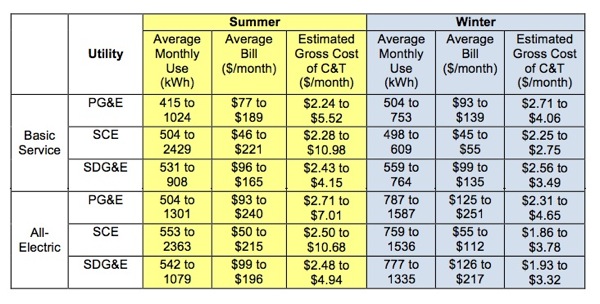State rebates could offset electrical sticker shock, finds a new study
 Forcing utilities to pay for their carbon emissions, as California plans to do, will mean more costly megawatts. Six months before formal compliance with the state’s new cap & trade system begins, regulators are still sorting out what to do about that.
Forcing utilities to pay for their carbon emissions, as California plans to do, will mean more costly megawatts. Six months before formal compliance with the state’s new cap & trade system begins, regulators are still sorting out what to do about that.
One of them is to provide rebates to offset hikes in electric bills. A new report from the clean-economy advocates, Next 10 attempts to sort out the options and put some concrete numbers on them. For example, the authors estimate that for PG&E customers, pricing carbon will add somewhere from two-to-seven dollars a month to summer electric bills, and anywhere from $2.50-to-more than $10 for customers served by Southern California Edison. Where you fall in that range depends in part on which of California’s many climate zones you live in. Places like the Inland Empire, which rely more on air conditioning, would fall in the upper end of the range.

Authors Dallas Burtraw and Sarah Jo Szambelan figure that there should be enough cash from cap & trade to completely offset increases to electric consumers from cap & trade, but not to offset increases from the state’s transition to renewable sources of energy.
We’re not talking about chump change here. Estimates of the state’s annual take from cap & trade range from somewhere between a half-billion and $1.6 billion in the early going, to nearly $6 billion once the program expands in 2015. It’s hard to pin down because no one really knows what the price of a metric ton of carbon will be. Around $30 is a number that keeps coming up in projections but no one will truly know until the market is up and running, late this year.
“Electricity costs are going to go up,” Burtraw says bluntly. The questions are: who bears the brunt of those increase? Exactly how to protect retail customers from electrical sticker shock is a topic of intense debate. So far, three main approaches have emerged in discussions:
- Use all the proceeds from utilities’ permit fees to offset electric bills
- Use 90% for rebates and invest the remainder in energy efficiency
- Split the money roughly 50/50 between investments in clean energy and efficiency
Presumably those “investments” would include offering homeowners deals on upgraded appliances, insulation, and so forth. Even the cash rebates themselves present a puzzle. Should your utility simply knock something off your bill, or send you a separate rebate check? It matters, says Burtraw, who argues that consumers should at least see the impact, if not feel it. Otherwise they might not be motivated to save energy. “If that cost increase is not passed along to ratepayers,” Burtraw told me by phone from New York, “then ratepayers, at their end, will not be making adjustments that reflect the real cost of electricity.”
Regulators are expected to decide on a plan in June.
One thought on “Cap-and-Trade and Your Electric Bill”
Comments are closed.

Cap and Trade – what a scam